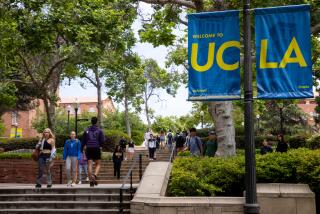UC Takes Steps Toward Creating Online Library
The University of California began tearing down the walls of its libraries Tuesday--at least symbolically--by making its enormous collection of periodicals, photographs and historical documents available to anyone with a computer and a modem.
UC President Richard C. Atkinson announced the new California Digital Library, which initially will develop computer links among the libraries on the system’s nine campuses, then expand to include material from other schools and museums, both public and private.
“The UC library system as a whole [with 29 million volumes] is the largest in the country next to the Library of Congress,” Atkinson said. “So that puts us in a very good position to begin this whole effort in such a strong fashion.”
The plan is to build electronic pathways so that scholars anywhere--or the merely curious--can use the Internet’s World Wide Web to browse among the professional journals and other materials held in university libraries around the state.
As a start, system librarians are busily scanning in special collections that soon will be accessible through a central electronic door.
For instance, UC Berkeley has digitized most of the Bancroft Library’s photos of early California (https://sunsite.berkeley.edu/CalHeritage/) and UC Santa Barbara has done the same with its map collection (https://alexandria.sdc.ucsb.edu/).
As examples of research sites outside UC that might be included, Atkinson pointed to a digital collection at the College of the Siskiyous, which features portions of John Muir’s diaries, and the J. Paul Getty Museum in Malibu, which displays many paintings online.
At the moment, most published electronic material--about 80% of what’s available--is in the fields of science and technology.
Many professional journals offer their articles online and UC hopes to save money by subscribing that way instead of ordering multiple copies for campus libraries. Industry or other subscribers would help foot the bill, perhaps by paying fees to retrieve material.
UC librarians also expect the university to move quickly into online publishing--in part because its professors are prolific contributors to professional publications.
“We produce the research and then we have to buy it back in expensive journals,” said Richard E. Lucier, recently appointed executive director of the California Digital Library. “We can get the research out there more quickly and keep our costs down.”
Lucier, who will based at UC headquarters in Oakland, is developing the project with State Librarian Kevin Starr. To advance the digital library, the university hopes to get $3 million from the state’s 1988-89 budget and kick in $1 million itself.
UC librarians point out that advancing technology makes it easier to sort, store and deliver information for teaching and research.
That’s not to say that the modem will soon replace the library card.
For the foreseeable future, the digital library will coexist with traditional ones, where students and scholars thumb through books they pluck from the stacks. There are no immediate plans to scan in many of the millions of books.
Yet university librarians--who hope to have their digital library running by mid-1998--are bracing for a virtual revolution.
“I see a time when students will do a substantial portion of research from their dorm rooms,” said Brian Schottlaender, UCLA’s associate university librarian.
That kind of electronic research will be available to the public too.
“Right now, you have to pay five bucks to park on campus, get a library card and make an appointment,” he said. “What the digital library will do is enable you to access this remotely from home.”
More to Read
Sign up for Essential California
The most important California stories and recommendations in your inbox every morning.
You may occasionally receive promotional content from the Los Angeles Times.










